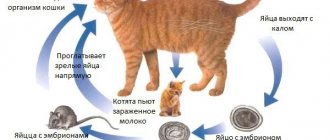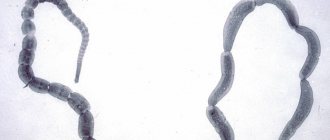Helminthiasis is a fairly popular disease of worms in the animal world, during which parasitic worms - helminths, as well as their larvae - settle in the internal environment of the affected animal's body. Humans, like cats, who have lived together since ancient times, are subject to helminthic infestations to the same extent.
Clinical manifestations of the disease stem from disruption and damage to the functioning of many organs. Therefore, animals need to be treated on time , since a sick four-legged friend suffers not only himself and requires the help of the owner, members of the family where the cat lives can also be affected.
In the article we will look at the most common types of parasites in animals, signs of the disease, and also - we will answer one of the most frequently asked questions - how to cure worms in a cat and what the parasites look like.
Causes of worms in cats and kittens
The main reason for the appearance of worms in mustachioed pets is the ingestion of parasite eggs into the cat’s body. This can happen in the following ways:
- eating fish and meat products without prior heat treatment;
- communication with other representatives of the cat family (as well as dogs) – carriers of worms;
- through insects - fleas, flies, mosquitoes;
- through rodents (helminth eggs may be on their skins);
- quenching thirst from a dirty pond;
- through the owner's shoes;
- “picking up” eggs from grass, ground and other surfaces.
Note: kittens can become infected with helminths from their mother through milk or even in utero, so it is important to promptly deworm cats before pregnancy.
Scheme of infecting a cat with the most common worms - roundworms of the genus Ascaris
Nematodes
Roundworms most often parasitize the small intestine, esophagus, and infect the liver. Nematodes are able to penetrate the kitten’s body even when it is in the womb. Therefore, roundworms are most often found in kittens up to 2 months old, while they are feeding on their mother’s milk.
Nematodes are the causative agents of helminth infections such as hookworm disease and toxascariasis.
Hookworm
Hookworm is a round white parasite with a slightly reddish tint, up to 2 cm long, which inhabits the small intestine. The worm bites through the mucous membrane to feed on blood. As a result of its activity, many bleeding wounds appear, which leads to blood loss in the cat. Helminths live in the host’s body, and their larvae exist for a long time in water and soil and move long distances during rain. One female lays up to 16 thousand eggs daily.
Infection occurs in 2 ways:
- Through the mouth, when the cat licks itself, it eats food contaminated with larvae. An outdoor cat becomes infected through the rodents it hunts. Mice are carriers of this type of parasite. In the body of a rodent, hookworms can exist for up to 10 months and remain viable. Entering the cat’s intestines through the mouth, the larva after 2-3 weeks turns into an adult capable of reproduction.
- The larvae burrow through the skin and then migrate through the blood vessels. Hookworms enter the trachea, which causes the pet to cough. When coughing, the larvae enter the mouth, then the animal swallows them, and they end up in the stomach and intestines. After about 3 weeks, a sexually mature worm is formed from the larva.
Why are worms dangerous for cats?
Developing in the cat’s body, worms cause enormous harm to the animal’s body. Firstly, they injure the mucous membrane of the digestive tract mechanically - they gnaw and pierce the intestinal walls with their spines and teeth. Penetrating into organs, they disrupt the structure of tissues and cells, limiting their functional activity. Sometimes the worms multiply to such an extent that they block the lumen of the small intestine, causing its obstruction.
The damaged tissues of the organs in which the parasites live gradually decompose. The released toxic compounds are carried by the bloodstream, leading to poisoning of the entire animal’s body. In addition, the worms themselves release toxins during their life processes and during decomposition after death within the body.
If a cat has worms, its immune system is severely affected. A weakened pet is unable to fight other infections, which is the cause of the development of various bacterial, viral and fungal diseases.
In the case of abundant reproduction of worms, the animal’s psyche also undergoes significant changes. Constant itching, pain and other sensations lead to the fact that the cat becomes nervous and irritable, its sleep is disturbed and its appetite disappears.
General information
It is believed that the youngest and, conversely, the oldest animals are most prone to the appearance of parasites. This is due to the fact that their immune system can no longer adequately respond to threats from the external environment, including the eggs of parasitic worms. In our climatic conditions, nematodes are the most common, since their eggs are the most resistant to seasonal temperature changes. However, parasitological specialists are inclined to believe that the widespread distribution of parasitic species of nematodes in nature . Flatworms in cats are not so common, but the possibility of infection with them cannot be ruled out.
The route of infection is most often nutritional, through contaminated food or water. In more rare situations, a transmissible type of infection is noted (through the bites of blood-sucking ectoparasites). In particular, this is how the cucumber tapeworm spreads. Remember that parasite eggs can persist indoors for a very, very long time. On the street they are not so durable, since there they are affected by UV radiation from sunlight, temperature changes and other negative environmental factors.
Symptoms of worms in cats
By what signs can one suspect the presence of worms in cats? First of all, the owner should pay attention to the following symptoms:
A cat's bloated belly may be a sign of worm infection.
- change in eating behavior - the cat begins to eat more than usual without gaining weight, or, on the contrary, even refuses its favorite food;
- disturbances in the functioning of the digestive tract - difficult bowel movements alternate with diarrhea, pieces of undigested food are present in the stool, which indicates a malfunction in the enzyme system;
- anemia, weakness;
- the animal often licks the anal area due to itching;
- the hairline becomes dull, the fur falls out and becomes disheveled;
- mucous membranes acquire a yellow tint due to damage to the liver and gallbladder;
- the abdomen noticeably increases in volume;
- sometimes a cough occurs (a sign of worms entering the respiratory tract);
- Blood and mucus may be present in the stool.
Attention: the owner must remember that similar symptoms can occur with other diseases. If you give your cat an anthelmintic without laboratory confirmation of helminthiasis, this may lead to a worsening of its condition.
Flatworms (cestodes)
As in the case of nematodes, cestodes are a very broad “worm” type, not all of whose representatives are parasites. In addition, not all flatworms are champions in body size. There are plenty of species whose representatives have an adult length of a couple of millimeters, or even less. However, there are often cases when some tapeworm can actually grow up to a meter (in the body of cats this is the maximum size).
The life cycle of many cestodes is very remarkable.
- First, many of these worms are hermaphrodites (but there are exceptions).
- Secondly, the entire body of many adult cestodes is like a “chain” of interlocking segments, tightly packed with eggs. Even one individual releases many hundreds or even thousands of eggs into the external environment in just a day. The fertility is simply fantastic.
Important! Given that the stool of a sick animal contains millions of parasite eggs, we do not recommend routine disposal of the contents of the litter box.
If the owner has such an opportunity, it is best to burn feces! When this is not possible, the contents of the tray should be packed in double bags made of durable plastic.
With such a number of eggs, the need for intermediate hosts does not arise very often, but still some species (for example, alveococci and echinococcus, as well as many tapeworms) still need additional “vessels” for the maturation of the larvae.
The routes of infection for flatworms are also simple: infection occurs exclusively through nutritional means, through the cat eating food contaminated with eggs or larvae of parasitic cestodes. There are most likely no routes of infection through breast milk, skin or other routes.
Why is infestation with flatworms so dangerous?
Why do many veterinarians consider cestodes one of the most dangerous internal parasites? To answer this question, you need to delve a little into the history of their occurrence, as well as the physiology of these parasites.
The fact is that cestodes (more precisely, their “evil” varieties) switched to a parasitic lifestyle a very long time ago. If we compare them with the same nematodes, which have preserved most of their organ systems, the flat varieties have an extremely simplified nervous system (in fact, it is not even centralized), digestion is completely absent, there is no oral cavity, etc.
The lack of its own digestion poses a particular danger: the body of cestodes is only able to absorb ready-made nutrients and assimilate them through the anaerobic cycle (i.e., oxygen-free).
Waste goes back to where the nutrients came from, that is, back into the intestinal cavity. During the anaerobic cycle, huge, catastrophic amounts of strong toxins are released. All of them end up in the animal’s bloodstream, which does not lead to anything good.
But this is not the only reason why cestodes are dangerous for an animal. Another problem is the method of securing them to the intestinal mucosa. In the best case (for the animal), fixation is achieved through suction cups. But hooks are much more common. Not only do they severely injure and damage the intestinal wall, but sometimes the head of the dead parasite can only be removed surgically.
Finally, cestode larvae. There is a special conversation about them. For some parasites of this type, the cat can be not only the definitive, but also an additional host. This means that the larvae can end up in any organ and any tissue (including the brain). Such situations are especially common in the case of alveococcus and echinococcus.
Invasion of flatworms is an extremely undesirable phenomenon, sometimes leading to serious consequences (such as death due to cerebral edema due to severe intoxication). At the slightest suspicion, you should immediately contact a veterinarian.
Important! Echinococci and alveococci are deadly for humans! Their larvae can form cysts in our body. Therefore, we strongly advise you to be careful when caring for a sick pet, constantly wash your hands and be sure to burn its feces!
Cucumber tapeworm (dipylidia)
One of the most common cestodeses of domestic animals around the world is the cucumber tapeworm.
The body of many adult worms of this type is a set of interconnected segments with eggs. This tapeworm is no exception. The severed segments of its body are elongated and narrow, they look like cucumber seeds. Actually, this is where the name of the parasite comes from.
In addition, the “seeds” have another feature that has nothing to do with their appearance: the segments of the worm’s body are able to move independently for quite a long time. When the “seed” crawls, eggs are squeezed out of special holes on its sides, seeding the entire surrounding space.
If you suddenly notice that strange cucumber “seeds” are constantly appearing around your pet’s litter tray, it’s time to take your pet to the vet.
Development cycle
The development cycle of the parasite deserves a separate story. There is no direct transmission: even if a cat eats a segment of the worm, infection will not occur. The thing is that the larvae of this tapeworm must mature in the body of... fleas. It all starts with the larvae of bloodsuckers living in cracks, under floor coverings, and in other secluded places.
They feed on organic matter, including eggs of cucumber tapeworms. The problem is that a worm egg, once in the body of a flea larva, is not processed by the latter’s body. The larva emerges from the shell of the egg, after which it “takes root” in the tissues of the future flea. There it matures to an invasive (i.e., capable of infecting) form.
A cat becomes infected when, while licking its fur, it swallows “special” fleas. The likelihood of this is very high, since infected bloodsuckers become more lethargic, inactive, sit in one place for a long time and do not jump much. It should be taken into account that small children can become infected in a similar way, constantly putting into their mouths everything that is within their reach. True, this will not lead to serious consequences, since the tapeworm does not survive in the human body.
Symptoms and treatment
The clinical picture is quite vague, there are no specific signs of infection:
- Digestive disorders are common. In a sick animal, periods of diarrhea may alternate with “dense” constipation.
- When the parasite grows, the volume of toxins it releases into the cat’s body will increase sharply. The consequence of this is a rapidly increasing intoxication of the body, manifested in the form of vomiting, and in severe cases it can lead to nervous attacks.
- Characterized by a perversion of appetite or (later) its complete absence, the stomach of a sick cat is greatly swollen and saggy. A specific sign of infection, of course, will be the presence of segments in the stool.
Drontal, melbemax, prazicide, and similar drugs are used for treatment.
Wide tapeworm
The disease that causes broad tapeworm is called diphylobothriasis. It is a very typical pathology for cats, since the intermediate host of the parasite is fish from the carp family. Some veterinarians believe that in settlements located along river banks, the degree of damage to the cat population can reach 100%.
This cestode has several features:
- Firstly, the size is amazing. This is the only type of parasitic flatworm whose representatives can grow in the body of cats longer than several meters.
- Secondly, the tapeworm is also dangerous for humans, but owners of sick cats have nothing to worry about. If he does not eat raw river fish, infection will not occur. It is vitally important for the eggs of the parasite to first enter the body of a freshwater crustacean (Daphnia or Cyclops), and then mature in fish.
Symptoms of infection and treatment
The symptoms of infection (as in all previous cases) are very vague and not specific, but still, in the case of the tapeworm, there is one sign that all sick animals have. The fact is that this parasite “respects” vitamin B12 very much .
Of course, this substance is massively “pumped out” from the host’s body, resulting in severe anemia. The mucous membranes and skin of the animal turn pale, the appetite sharply worsens, and severe exhaustion develops. In addition, advanced cases are characterized by attacks of thin, watery diarrhea with a very unpleasant odor. From time to time, violent vomiting is observed, and segments of the parasite often come out along with the vomit.
For antiparasitic treatment, the following are used: arecoline, fenasal, as well as bunamidine hydrochloride, lopatol. Anemia is eliminated by prescribing a diet high in protein, vitamin B12, and iron.
Diagnosis of helminthic infestations
It is not difficult to guess that a domestic cat has worms if they (or their particles) come out along with feces or vomit.
Otherwise, if the above symptoms appear, and also periodically as a preventive measure, you should contact a veterinary clinic for diagnosis. It is better if the owner brings the animal directly to the veterinarian, because feces alone are in most cases not enough to detect parasites. This may be due both to the localization of helminths and to their insufficient maturity, when the worms are not yet able to lay eggs. Your pet's blood will be taken for laboratory testing and, if necessary, a sputum test will be prescribed. In some cases, the doctor may refer the cat for an X-ray examination of the lungs or an ultrasound examination of the liver and heart. In the process of identifying helminthiasis, they are differentiated from diseases of internal organs, poisoning, and colds.
Cucumber tapeworm
One of the most common tape parasites in cats and dogs (it is more common in dogs). In addition, the worm is very dangerous, as it can cause severe intoxication in the body of a sick animal.
The Latin name of the pathogen is dipylidium caninum. The body of the parasite consists of many small segments capable of independent movement for about a day. The body length of an adult individual can reach two meters (in the body of a cat, the worm rarely grows more than half a meter). Infection very often occurs when a cat eats small rodents, as well as as a result of bites from blood-sucking ectoparasites.
The infection is quite severe. In particular, sick pets often vomit and develop chronic diarrhea, occasionally interspersed with periods of constipation. The pet's feces turn out to be saturated with segments of the parasite, which in appearance resemble grains of rice. If you see similar formations in your bed where your cat was previously lying, take him to the vet immediately! As we have already mentioned, the segments are capable of moving independently for some time , and therefore they can be found even under the pillow, not to mention other places in your home! Note that during movement the segments contract, squeezing out hundreds of eggs along the way. So, if there is at least one sick animal in the house, the number of parasite eggs constantly present in the house can reach hundreds of thousands!
Thus, to prevent subsequent infections, it is highly recommended to regularly wet clean rooms with chlorine bleach in “shock” doses. It is also necessary to take a responsible approach to the process of completely eliminating fleas.
Treatment of worms in cats
Treatment of worms in representatives of the cat family is carried out comprehensively and consists of solving several problems:
- destroy parasites;
- ensure their rapid removal from the animal;
- detoxify the body;
- restore immunity and functional activity of damaged organs.
For this purpose, anthelmintic drugs are used, which can be intended for both internal and external use. The products are available in different forms: deworming tablets, suspension, injections, drops.
Antihelminthics for cats for oral administration
Lungworm cycle
Medicines for deworming in cats intended for internal use have different effects on parasites. Some destroy the integumentary tissues and shells of eggs, others negatively affect the nervous structures, leading to paralysis of the helminth, and others disrupt metabolism. In addition, some drugs act only on adults, while others destroy larvae and eggs.
In accordance with the components included in the medications for worms, they are divided into broad-spectrum drugs and those aimed at exterminating only one type of helminth. The latter can be used only after an accurately established diagnosis.
Among the most common complex preparations for worms in cats are:
- Milbemax;
- Prasintel;
- Drontal;
- Prazicide;
- Fenasal.
When ridding your pet of worms, you need to carefully monitor its condition. Mass death of parasites can lead to severe intoxication of the cat, especially if there are significant numbers of them. An animal weakened by helminths may experience vomiting and diarrhea. You can help your pet with absorbent agents: you need to give activated carbon, enterosgel or others.
Deworming products for external use
External medications for helminths in cats are presented in the form of drops that are applied to the withers. These are: Bars, Profender, Drontsid and others. Such funds have both pros and cons. The first is ease of use, the main thing is that the animal cannot lick the place where the drops are applied. In addition, such a medicine destroys not only internal, but also external parasites - fleas and ticks, and also serves as a preventive measure for their appearance.
Among the disadvantages, the effect of the medicine is not strong enough, especially with a significant number of helminths. Drops are absolutely useless to use for helminthiasis caused by trematodes; the greatest effect is achieved if the disease in a cat is provoked by nematodes.
Injections for worms
In difficult cases, the veterinarian will prescribe anti-worm injections for the cat - Ivomec or Ivermec. The procedures will need to be carried out in a clinical setting, since preparing the solution yourself can lead to errors in dosage and the death of the animal.
Attention: the injection form of the medicine is not a prophylactic agent.
How to find out that a cat has worms if their eggs are not found in the feces
Lungworms are manifested by a cough, but coughing can be a symptom of other diseases. Based on this, the only real way to protect an animal is to prevent helminthic infestation.
This procedure is absolutely painless, and now there are pills that are taken once and not necessarily on an empty stomach. Fleas are carriers of some types of worms, so if you find fleas on a cat, there is a high probability that there are also worms.
To rid a cat of parasites, you need to know what type of worms the animal is infected with. For example, a drug can be effective against roundworms and harmless against tapeworms. It is advisable to take broad-spectrum drugs under the supervision of a veterinarian.
Prevention of helminthiasis
To prevent the appearance of worms in cats, it is enough to adhere to the following preventive rules.
- Avoid contact of your pet with unfamiliar or infected animals.
- When returning from the street, put your shoes in a separate closed place, not allowing the cat to sniff them. Wipe the hallway floor several times a day using disinfectants.
- Regardless of whether the cat goes outside or not, treat it with external products against fleas and other parasites.
- Eliminate raw fish from your mustachioed friend’s diet.
- Wash the tray and food bowl thoroughly and regularly.
Flea remedies
Before deworming, you need to get rid of fleas, which are an intermediate host for worms. Currently, veterinary pharmacies provide a wide range of products to help cope with this problem.
Most used:
- Drops on the withers. Distributed throughout the fur. For example, Advantage.
- Sprays. For example, Frontline.
- Shampoos are most often used to get rid of fleas in small kittens. For example, Rolf Club.
- Collars are more suitable for prevention. Hartz et al.
- Powders are approved for use in pregnant cats.
The most effective way to get rid of fleas is a combination of several types of products. For example, wash the animal with shampoo and treat the fur with spray.
Which cat worms can be transmitted to humans?
Take preventive measures when interacting with a cat, especially if you suspect the presence of worms
Although cats can be hosts to many types of helminths, not all of them are able to take up residence in the human body. For example, flukes pose a threat to the health of the owner: liver, pulmonary and other types. These worms “settle” in the internal organs of a person (liver, lungs), leading to disruption of their functions, tissue decay, hemorrhages, and even death.
Tapeworms, such as alveococcus, cucumber tapeworm and others, can also lead to the death of the owner. Anemia, allergies, blindness, death are the consequences of a person being infected by a cat with roundworms and nematodes.
It is especially important to prevent infection of children in families with cats. It is necessary to explain to the child why you should not kiss an animal, that after contact with it you need to wash your hands with soap, that you should not pet stray kittens on the street, and so on.
Manifestations of various types of parasites
There are a large number of parasites that feed on the human body. Each of them affects different internal organs and has individual symptoms.
- Enterobiasis is caused by pinworms. A characteristic symptom of the disease is severe itching of the skin in the anal area, which intensifies at night.
- Ascariasis can cause fever, dry cough and allergic reactions. When infected, the child loses weight. At an advanced stage, jaundice, pancreatitis and intestinal obstruction may develop.
- Trichuriasis causes anemia and goiter. The stool is loose, the child is lethargic.
- Urogenital schistosomiasis leads to inflammatory diseases of the pelvic organs and urinary disorders.
- Trichinosis is characterized by muscle pain, chills and facial swelling in a child.
- Symptoms of opistrochiasis are liver damage, the appearance of jaundice of the skin, mucous membranes, sclera of the eyes, diseases of the pancreas, gall bladder and spleen.
The severity of the disease depends on the number of parasites feeding. If there is only one worm in the intestine, the symptoms may be almost unnoticeable; if there is a large accumulation of parasites, all the symptoms manifest themselves especially strongly.
How to give your cat deworming medicine
Many owners are faced with the problem of how to give a pill to a cat. Pets resist in every possible way the owners’ attempts to open their mouths and push an incomprehensible bitter thing into it. To prevent physical and mental injury on both sides, you can use a number of proven techniques:
- crush the tablet into powder and pour it into your mouth;
- dissolve the tablet in a small volume of water, draw it into a syringe and pour it into the cat’s mouth;
- use the tablet dispenser.
How to properly rid a cat of worms
In order for your pet to be treated for helminths with the greatest effectiveness, firstly, you should carefully study the instructions for the medicinal product. It is important to strictly follow the dosage recommended by the veterinarian or the annotation (in case of self-therapy). Before starting treatment for helminthic infestation, the animal must be treated for external parasites.
Some cats manage to hold the pill in their mouth and then spit it out, so the owner must not only place the medicine in the pet's mouth, but also make sure that it is swallowed.
In most cases, deworming medication is given to the cat twice, with an interval of two weeks. This is due to the life cycle of parasites. If the disease is advanced, the doctor may prescribe longer therapy.
After deworming, you must make sure that the activities were successful. This will require repeated control tests.
Preventive actions
Let us immediately warn you that it is almost impossible to be 100% insured against the penetration of parasitic worms into your pet’s body. To begin with, many types of worms can be transmitted from animal to animal through the bites of fleas and other ectoparasites. In addition, insects can be mechanical carriers of parasite eggs.
The latter, by the way, for the most part have an enviable degree of resistance in the external environment, being able to maintain their virulence (the ability to infect) for months and even years. They are especially durable in indoor conditions, since eggs there are not affected by UV radiation and other “aggressive” environmental factors. Thus, when purchasing used care items, you must thoroughly wash and disinfect them. If the cat is already undergoing treatment for helminth infections, it is necessary to constantly wash and disinfect the room in which he is constantly located.
If you take a cat from a nursery/shelter “in addition” to your existing pets, both it and your cats must be treated with anthelmintic drugs. Practice clearly proves that in places where pets are kept crowded, the degree of infection by helminthic diseases can easily reach 100%.
Let us once again emphasize the importance of protecting pets from fleas . How to achieve this with maximum results and minimum costs? There is one simple folk remedy. Sagebrush. Place its fresh or dried leaves in your cat's basket and place them in secluded corners of your home. Fleas are not guaranteed! The same effect can be obtained by using wormwood essential oil. You can buy it at any pharmacy. You can treat your pet's fur with the same composition (but no more than a couple of drops). It must be applied in places where the animal cannot lick the drug (it is extremely bitter).
When not to deworm
There are several situations when you need to wait a little while treating cats for worms:
- serious condition of the pet;
- exacerbation of infectious diseases;
- cat pregnancy;
- lactation period;
- newborn kittens (usually age restrictions are indicated in the annotation for the drug).
It may also be difficult to deworm an aging cat. At this age, an animal should be treated for worms only in consultation with a specialist.











